WHITE HEAT (1949)
A psychopathic criminal with a mother complex makes a daring break from prison and leads his old gang in a chemical plant payroll heist...
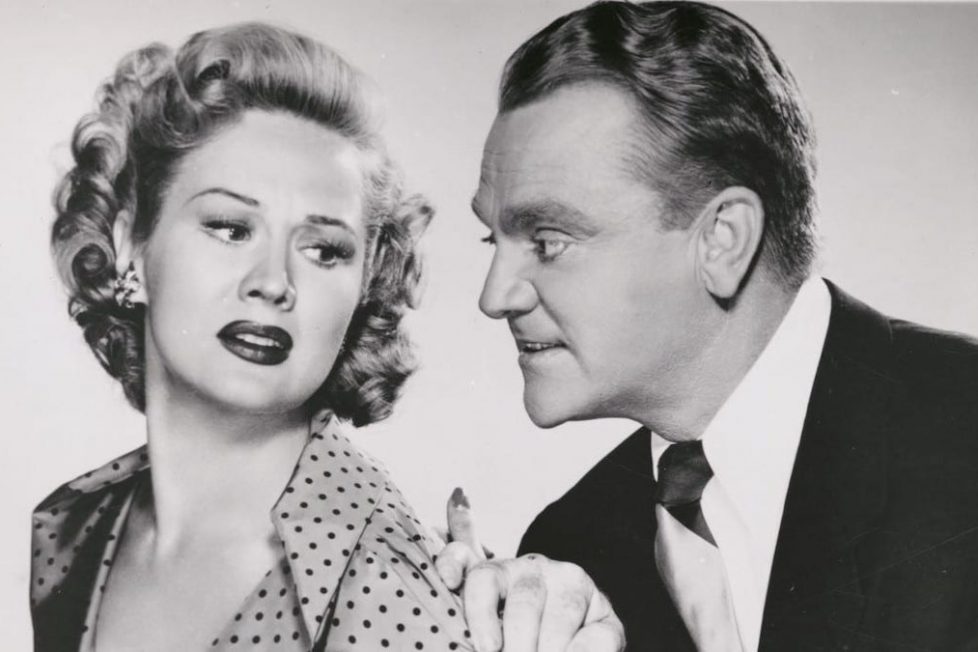
A psychopathic criminal with a mother complex makes a daring break from prison and leads his old gang in a chemical plant payroll heist...


Made it, Ma! Top of the world!
Chances are you’ve heard that line quoted out of context, usually highlighting one’s hubris. It’s up there with “Toto, I’ve a feeling we’re not in Kansas anymore.” Or “I love the smell of [whatever] in the morning…” Lines that have developed a life of their own beyond the films they originated, becoming part of cinema’s iconography and the wider culture.
Most people reading this will probably know the “Top of the world!” line was first delivered 70 years ago by the great James Cagney, as unhinged gangster Cody Jarrett, during the incendiary climax of White Heat. Though it’s cropped-up in plenty of films and television series since—you might know it from an episode of Cheers (1982-1993) or Breaking Bad (2008-13), or even quoted in the lyrics of a pop song…
Even in 1949, White Heat was a ‘post-modern’ throwback resurrecting genre tropes laid down in the Golden Age of the gangster movie (the early-1930s). Back then, the archetypal gangster boss was pretty much templated by two classic pre-code crime dramas: Little Caesar (1931) starring Edward G. Robinson as Caesar “Rico” Bandello, and James Cagney’s first leading role as Tom Powers in The Public Enemy (1931).
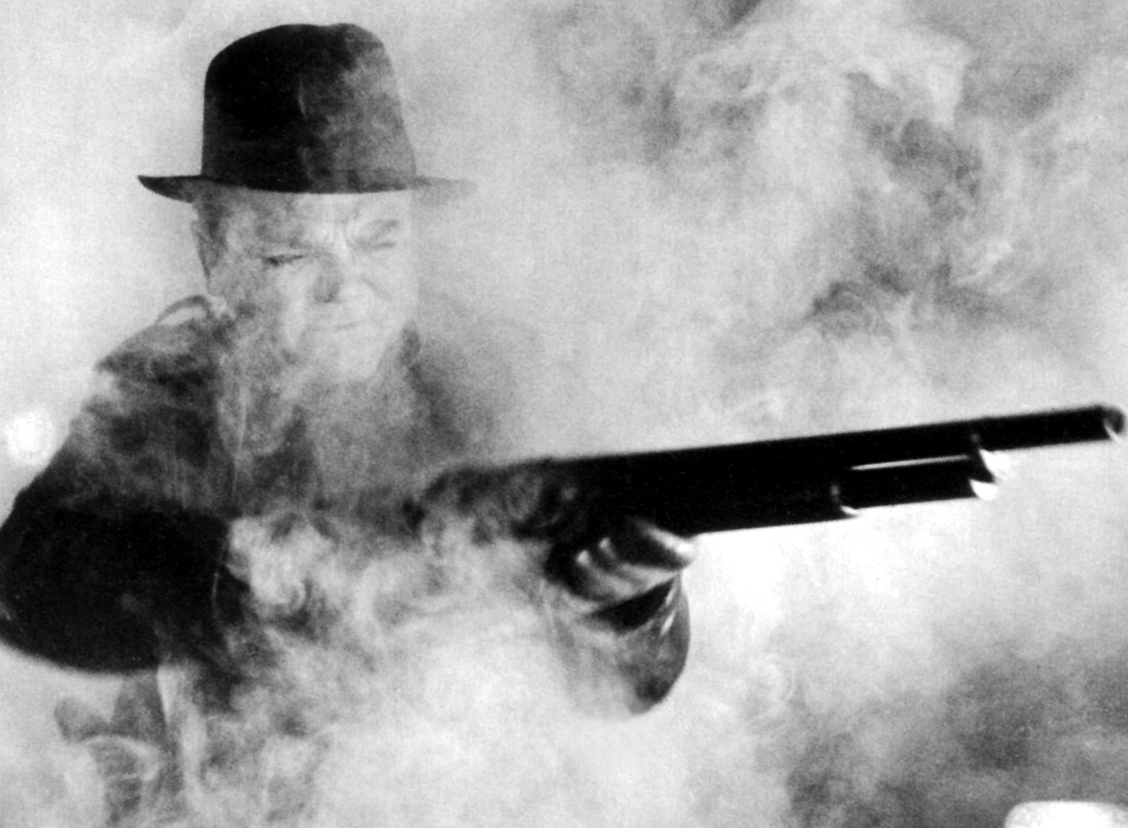
Both were incredibly popular with cinemagoers but courted controversy for glorifying the amoral gangster lifestyle. But during the Great Depression and Prohibition, black marketeering was rife. It was likely that most people knew someone who broke the law from time to time or brought in extra earnings with a dubious side-hustle. Outlaws and bank robbers didn’t seem all that bad. After all, many people were beholding to the banks and plenty had been forced into poverty through loss of their jobs and subsequent foreclosure on mortgages and loans. In common experience, bankers, and bosses were the bad guys.
So audiences found the arrogantly assured, self-made-man stereotype a hugely attractive form of escapism from their increasingly desperate and squalid reality. Their lives weren’t great but, up there on the silver screen, those gangster fellas were having a wild time! Sure, the wiseguys got their comeuppance in the final reel but they enjoyed the glamorous glitzy high life of celebrities along the way. For this reason alone, many of the gangster films to come out of the early-’30s were condemned by Federal authorities, Senators, and the like, to such an extent that some cinema chains were edging towards boycotting the genre. The Motion Picture Production Code, better known as the Hays Code, was set-out in 1930 but hadn’t been enforced until 1934. Its legal backing came as a response to the upsurge of hard-hitting crime thrillers and gangster films.
Interestingly, gangsters and outlaws were standard coverage in the newspaper headlines of the day. The mass media had deliberately kept real-life gangster ‘superstars’ in the public eye at the behest of the FBI and its leader, J. Edgar Hoover. He repeatedly denied that organised crime existed in America and so chose to focus the resources at his disposal on tracking down, killing, or capturing robbers, outlaws, and racketeers. It was easier than taking on the Mafia as their influence pervaded big business, high-level politics and, ironically, Hollywood. It has been said that many a Mafia boss fashioned themselves after the screen personae of Robinson and Cagney! Mafia money began to flow into Hollywood and influenced the studio system for decades to come. (Just ask Coppola or Scorsese!) Reality and fiction intermingled…
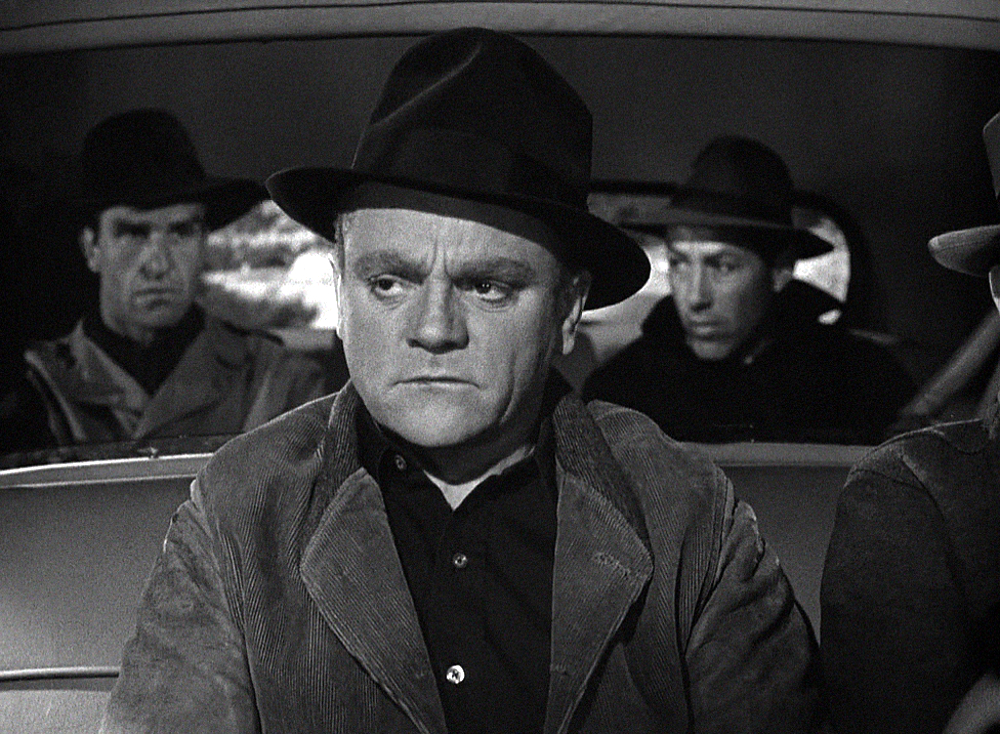
On numerous occasions, Cagney was a fly in the ointment for both the FBI and the mob-backed film industry. He was instrumental in forming the Screen Actors Guild (the union that protects the rights of performers) and refused to pay unreasonable taxes imposed by the studios to raise money to fund their pet political factions. Reportedly he was once the target of a real-life (or should that be real death) mob contract that planned to ‘rub him out’ by having heavy lighting equipment fall on him during filming. The hit was only revoked after his fellow actor with ‘connections’, George Raft made a timely phone call.
Cagney was accused of being a communist in 1934 for donating funds to help striking cotton-pickers. The stigma stayed with him and he was brought before the House Un-American Activities Committee in 1940. He was cleared of the charges and to make it perfectly clear that he wasn’t ‘un-American’, he made his super-patriotic musical Yankee Doodle Dandy (1942), for which he won ‘Best Actor’ at the Academy Awards and New York Film Critics Circle Awards.
His sense of social justice came with growing up in Lower East Side New York, a down-at-heel working-class area where he was known as a tough street-fighter with a passion for dancing; a combination that almost led him into a professional boxing career. But he was more fascinated by the film industry and used to sneak into the Brooklyn-based Vitagraph Studios to see what went on behind the scenes. He took up amateur dramatics at a local ‘settlement house’ where middle-class volunteers helped to provide opportunities and social networking for the ‘underprivileged’.
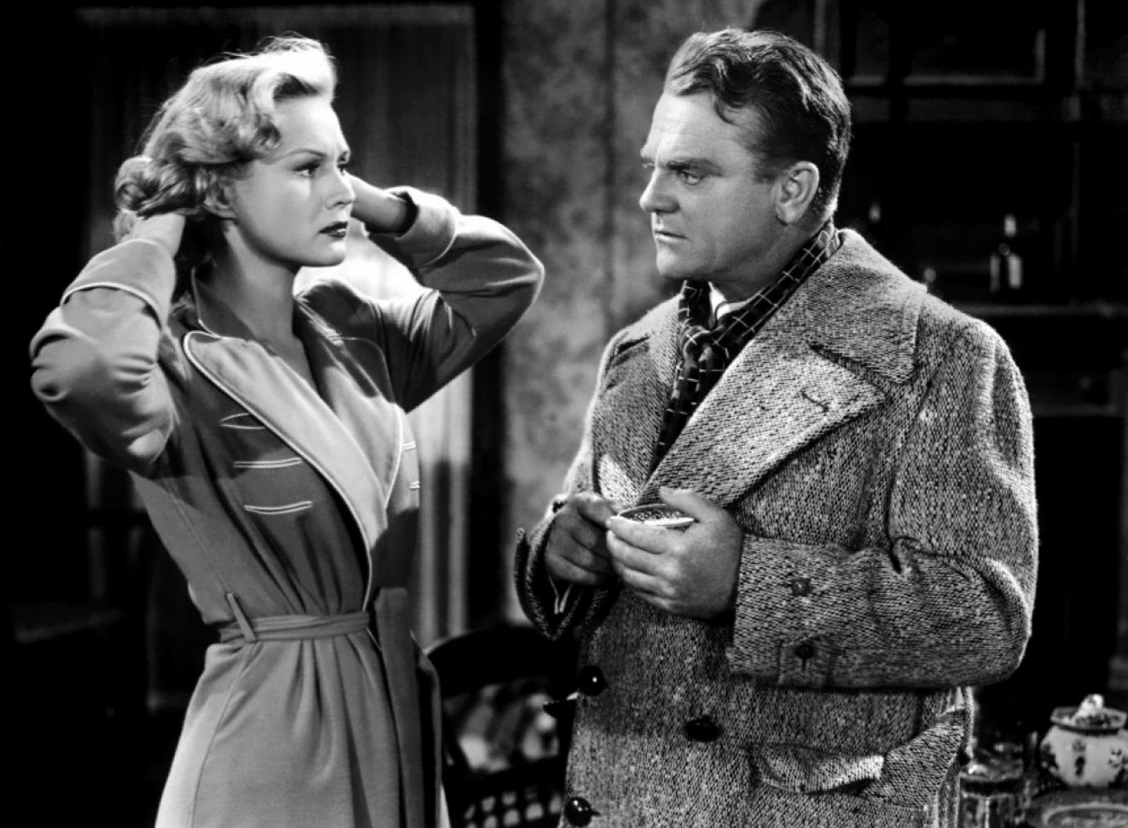
His screen debut was as Lucille La Verne’s son in Sinners’ Holiday (1930), a story about rum racketeering in the Prohibition. It was a Warner Bros. production and the studio was quick to recognise Cagney’s potential and offer him a contract. They saw his background would give him an edge over his peers, who had either progressed from the Silent Age or were coming out of reputable stage schools after being taught to enunciate properly.
Cagney was the real deal—a rough kid from New York with an authentic street demeanour and a genuine accent. For his second film, the B Movie crime drama, The Doorway to Hell (1930), he was cast as a gangster, and again for his first lead role in William Wellman’s The Public Enemy, so he was indelibly linked with the genre despite showcasing his song and dance skills in musicals and comedies.
He was deliberately cast against type as tough FBI agent James “Brick” Davis in ‘G’ Men (1935), in a contrived attempt by the Warner Bros. studios to appease some reactionary political factions that were criticising the trend of glorifying gangsters in popular cinema. Cagney played the lawman with the same physical energy and cadence as his gangsters.
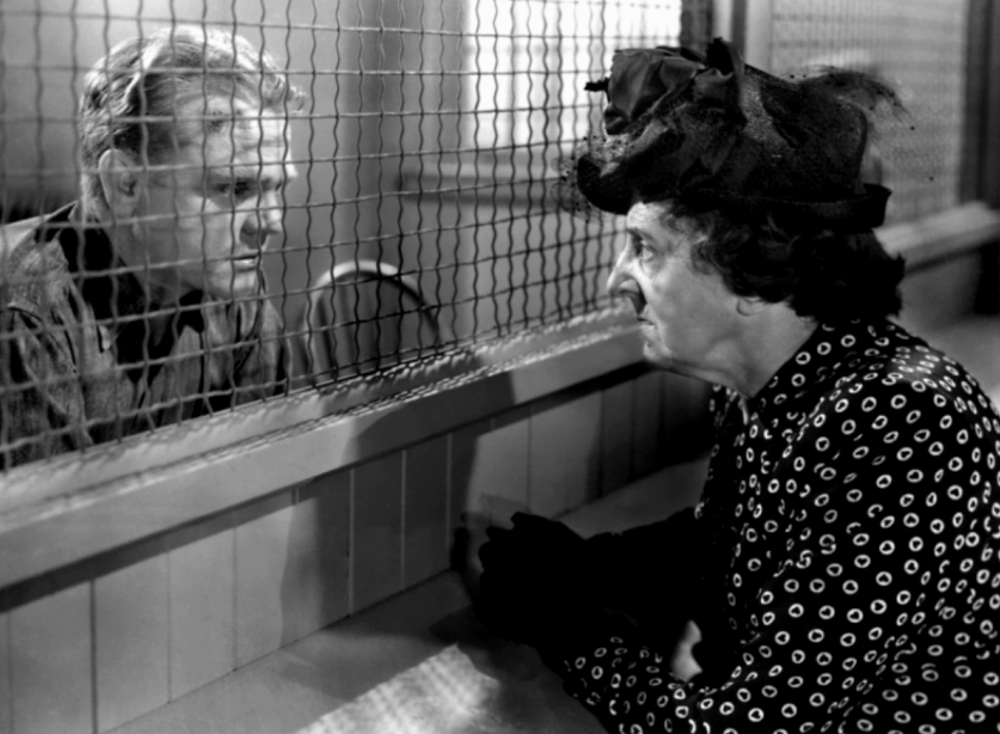
It was made the same year that the FBI was formed, so was bang on topic, and with the Hays Code tightening its grip on Hollywood, the sensationalist ‘gangstersploitation’ movie was a thing of the past. Also, by 1935, most of the ‘headlining’ real-life gangsters like John Dillinger, Bonnie and Clyde, Alvin “Creepy Ray” Karpis, Ma Barker, and all but one of her boys, were dead. J. Edgar Hoover had exploited the public obsession with gangsters to push through the formation of his FBI.
The script for White Heat started out as a story by Virginia Kellogg, a journalist and veteran writer of pre-code B Movies and radio plays. It was intended to be adapted into a biopic of Ma Barker and her four sons, focussing on the final few years when they were declared public enemies, up to the siege and fatal shootout with the FBI. Ivan Goff and Ben Roberts were tasked with expanding and adapting the story into a screenplay. The duo was to become a writer-producer team for the rest of their long careers, probably best known as co-creators of TV’s Charlie’s Angels (1976-1981), but at this point had never written together. They bounced the script around for the following six months, meticulously plotting the action and role-playing the dialogue line by line.
When director Raoul Walsh was finally handed the script, he wasn’t impressed. This would be his third film directing Cagney after they’d worked together on another classic gangster film, The Roaring Twenties (1939), and the comedy romance The Strawberry Blonde (1941). Walsh advised him to walk away from what he felt had been overworked into a turgid potboiler.
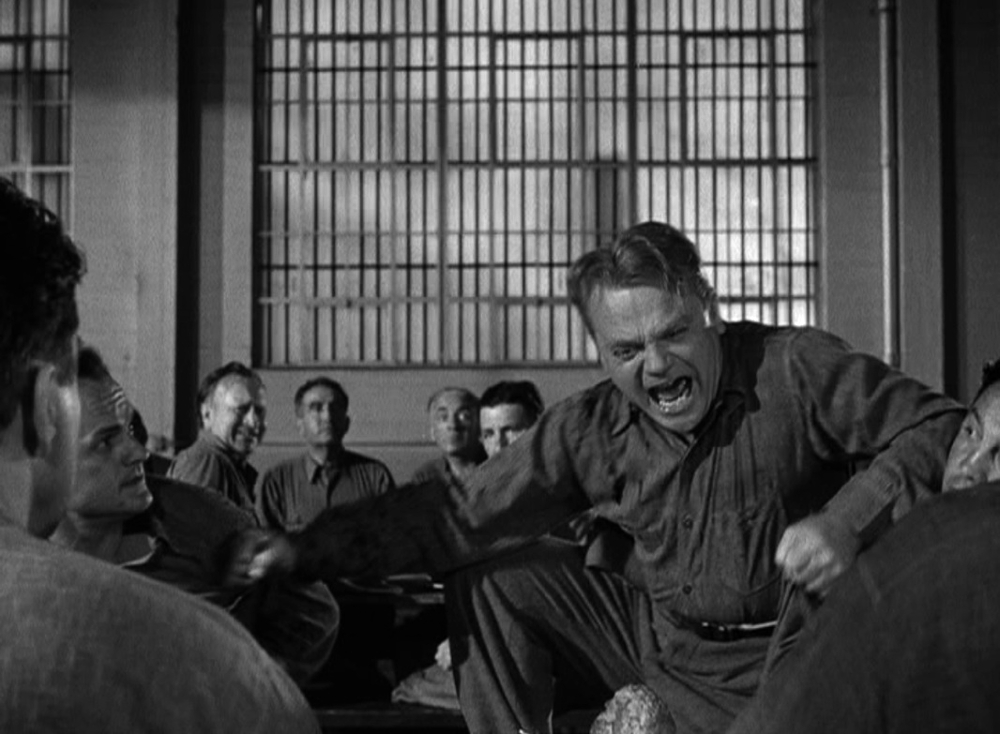
Cagney didn’t walk away but instead brought in a couple of actor friends to help him rewrite the script. Those friends were prolific actor Frank McHugh and Humphrey Bogart, fresh from his role in John Huston’s Key Largo (1948), alongside the great Edward G. Robinson. Bogart and Cagney had known each other since the late-1920s when they’d both started out on the New York stage and cemented a rapport when they starred together in Angels with Dirty Faces (1938) for which Cagney won a couple of ‘Best Actor’ awards and his first Oscar nomination for his portrayal of Rocky Sullivan, heroically playing the coward on his way to the electric chair.
The three of them quickly turned the script around, incidentally earning original author, Virginia Kellogg, an Academy Award nomination for ‘Best Story’. Cagney and Bogie worked on the dialogue and stripped the story down to the basics to make it less cumbersome. They decided to veer away from any ambitions of historical accuracy and turned it into a fiction ‘loosely inspired by’ the Barker gang rather than a biopic. This proves to be a good decision as a docudrama, bogged down with facts, wouldn’t have been half as much fun! They allowed their Ma Jarret just one son instead of four, which simplified things and focussed more on their relationship and the psychological aspects of criminality. McHugh wrote the action-driven opening in which Cody Jarret (James Cagney) leads his gang in a ruthless train robbery.
In the cleverly choreographed sequence, we’re given a very broad portrait of Cody Jarret as a cold, quick-thinking killer. We first meet him as he jumps from above a tunnel mouth onto the emerging train and makes his way along the carriage tops to the engine. When one of his men uses his real name, he logically kills the driver and engineer who could now identify him. The driver falls on a handle and releases a jet of steam that scalds and blinds one of the gang’s lookouts.
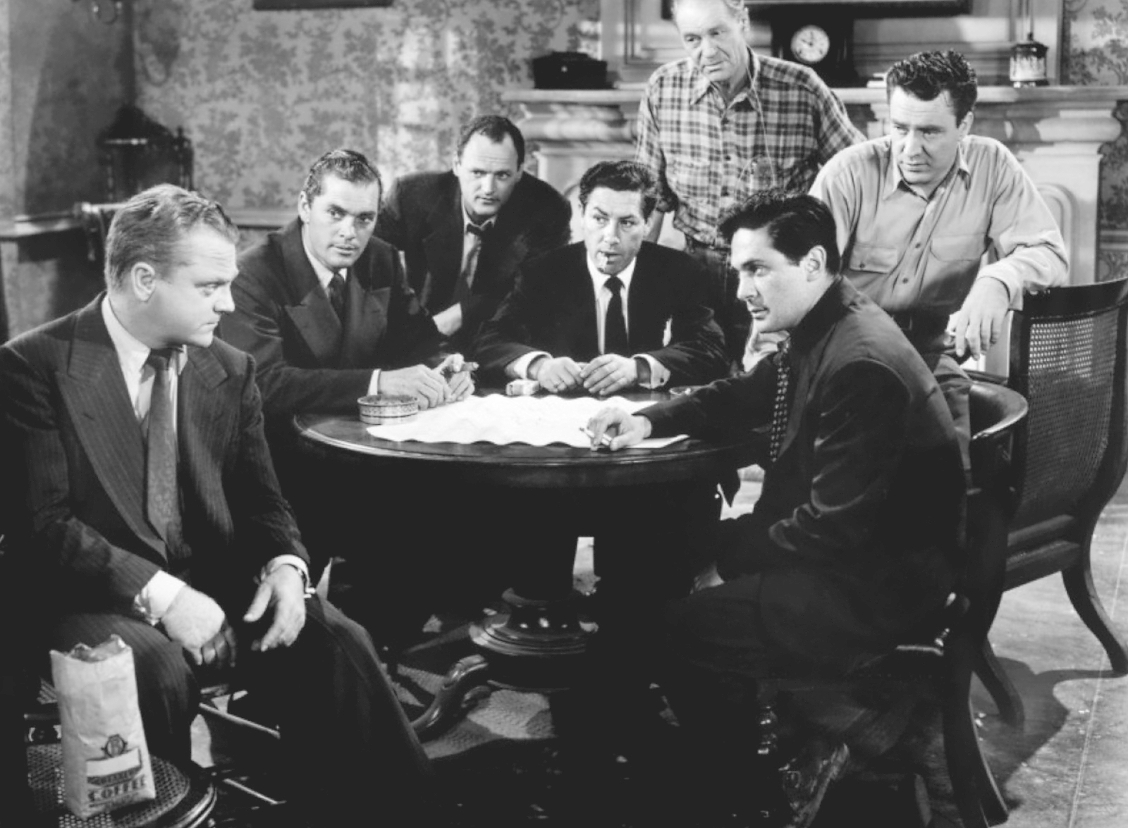
They make their getaway with stolen Treasury Reserve money and one of the men is heard to mutter “Ain’t safe havin’ a crackpot givin’ orders, ‘bout time someone took over…” We later get to know the man as Big Ed (Steve Cochran), who’s vying to take control of the gang. McHugh gives us a fine, fat-free set-up that immediately grabs the audience and in a matter of minutes has outlined some of the main players, laid out several important plot components and thrown in a complication for the gang on the run with a man down who really needs hospital treatment…
White Heat is most definitely a gangster movie, almost definitively so, but it’s also from the heyday of film noir. To be expected when the cinematography was in the capable hands of Sidney Hickox, who had already shot over 130 features for Warner Bros., including a hattrick of key noirs starring Bogart and Bacall: To Have and Have Not (1944), The Big Sleep (1946) and Dark Passage (1947).
One of the enduring strengths of White Heat is that it doesn’t tie itself entirely into a single genre. After the action of the opening sequence, the setting for the first act is an isolated house in the country where the gang lay low for a while awaiting the approach of a hurricane. We have the unfortunate blinded man with bandaged head and hands struggling to smoke a cigarette, and we’re introduced to a variation of the Gothic family trope that has echoes of The Old Dark House (1932). We meet Ma Jarret (Margaret Wycherly), who seems to be driven primarily by maternal love for her son Cody. We’re told that, as a boy, he used to fake headaches to gain her attention and as he grew older they became real head-splitters that only Ma can soothe, and we’re not too far in when Big Ed’s “crackpot” diagnosis is proven to be fair. We also meet Cody’s wife, Verna Jarrett (Virginia Mayo), who only really seems interested in music, booze, bed, and ermine. Her alliances are mercurial and she fits the bill as the film’s femme fatale.
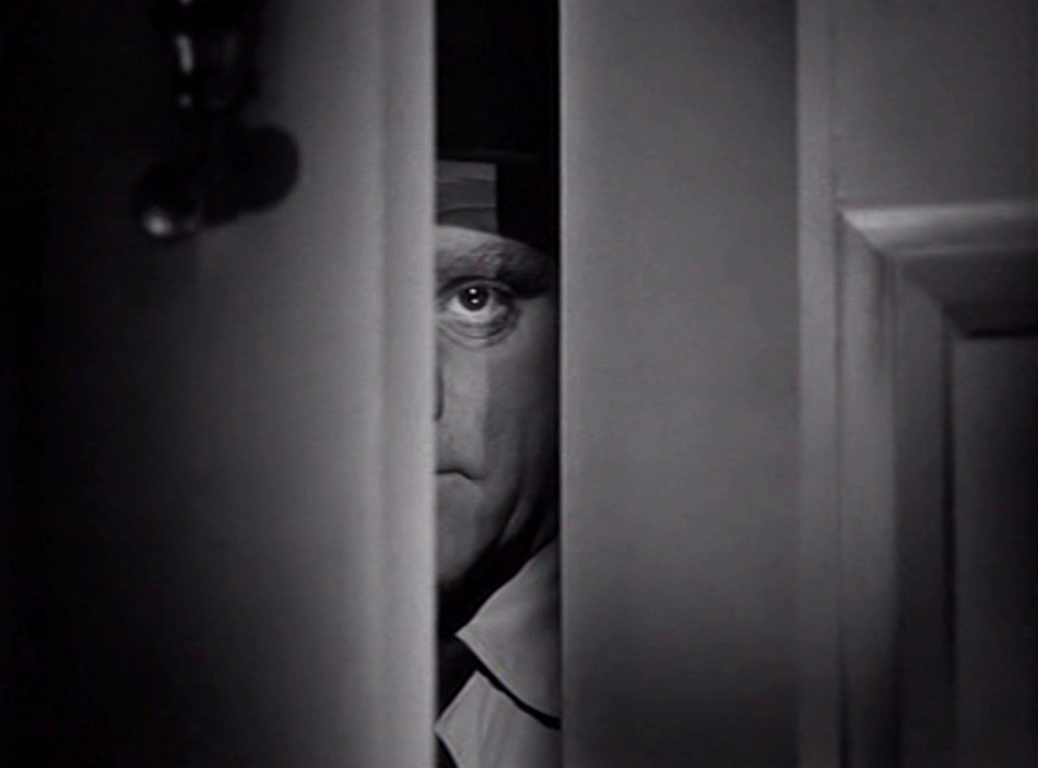
With the introduction of the T-men (Treasury agents), Philip Evans (John Archer) and Hank Fallon (Edmond O’Brien), we move into police procedural format as they bring what must have been cutting-edge detection methods into the mix. Using forensic micro-photography they tie the dead body of a man with face and fingerprints scalded beyond recognition, to the train robbery by matching dust found on the dead guy’s suit to a sample from the railway tunnel. They also identify a fingerprint on the cellophane of a cigarette packet in the jacket pocket that belongs to a known member of the Jarret gang.
They manage to track down Cody, Verna, and Ma in a rather sedate yet successfully suspenseful car chase through beautifully lit night streets that look like the kind of America found in the paintings of Edward Hopper. They lose their quarry in a drive-in movie lot. Cody then decides to turn himself in, but for another petty crime that he knows occurred elsewhere at the same time as their railroad heist.
Of course, he’s found guilty by his own admission and given a comparatively light two-year prison sentence. The guilty verdict is his alibi and now he can’t be tried for the other crime. After the short stint behind bars, he’ll be out to collect his share of the takings. Or so he thinks…
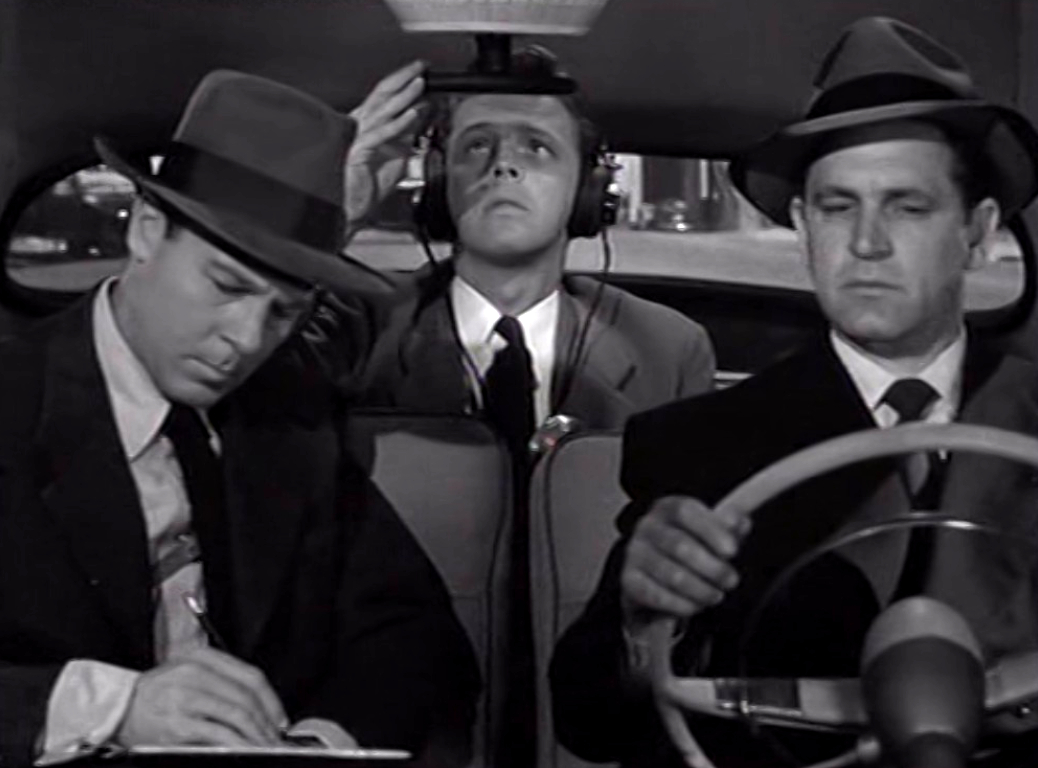
Now the police procedural format morphs into a classic prison drama as T-man, Hank Fallon goes into jail under the alias of Vic Pardo to gain Cody’s trust as one of his cell-mates. The plan is to help engineer their escape and let Cody lead him back to his gang and the stolen money. The plan starts to fall apart when the prison psychiatrist assesses Cody and begins the process of having him committed to a long-term institution on grounds of insanity.
There’s a surprisingly affecting scene between Cagney and O’Brien when the undercover cop covers for Cody as he suffers one of his debilitating headaches. The flying sparks and swarf of the machine shop provide a visual metaphor for the internal turmoil that subsides as Fallon/Pardo, at least partly, fulfils the role of Cody’s missing Ma and earns his trust.
It all goes rather Shakespearean from then on as Big Ed and Verna plan to do away with Ma and take control of the gang. In prison, Fallon’s cover is nearly blown a few times as lies are played against lies. Big Ed has his inside man attempt to murder Cody, who is saved by the intervention of Fallon/Pardo…
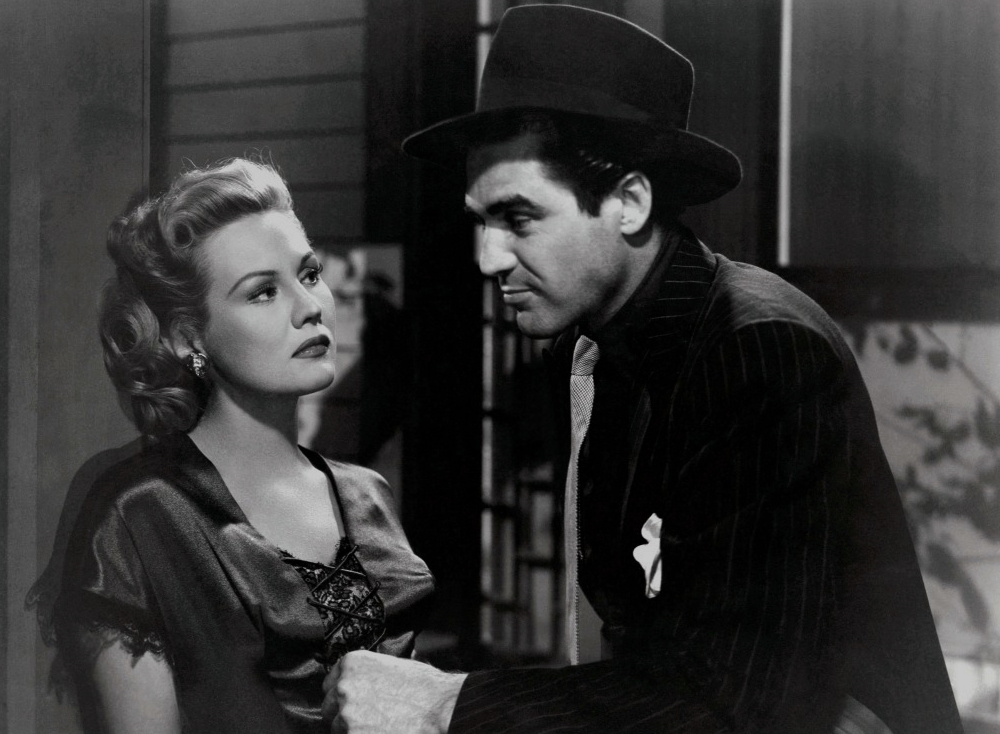
We’re just about half-way through when the tension really ramps-up and the undercover T-man has to go even deeper undercover when Cody takes things into his own hands and hatches a more violent, and effective, prison break plan. The action unravels through the second half at an increased pace towards the memorable finale played out during a botched heist at a fuel processing plant and the explosive final sequence. James Cagney had some of the most memorable death scenes in cinema history!
So, it may be in black-and-white and in that old squarish screen format, but in many ways, White Heat is surprisingly modern and still works as a well-scripted and inspired piece of cinema. That’s why it’s still ranked by the American Film Institute (AFI) among the Top 10 Greatest Gangster Movies. The entire cast does a solid job, especially Edmond O’Brien when he shares his scenes with Cagney, but it’s really held together by a superb Cagney performance that vibrates with energy throughout. He’s not ‘method’ but certainly naturalistic. By today’s standards somewhat broad, but I dare say some of those gangsters who came up from the streets were often putting on an act and were quite broad personalities!
Cody’s a bad guy. He’s a psycho if ever there was. But Cagney still manages to elicit sympathy for him. He was famous for using his expressive ‘cow eyes’ with their long lashes and fluid depth but, for much of the time, they’re averted from his co-stars and the audience. He very deliberately brings them to bear when it counts and the scene when Cody realises he’s been betrayed is one of Cagney’s finest moments. Deceptively emotive.
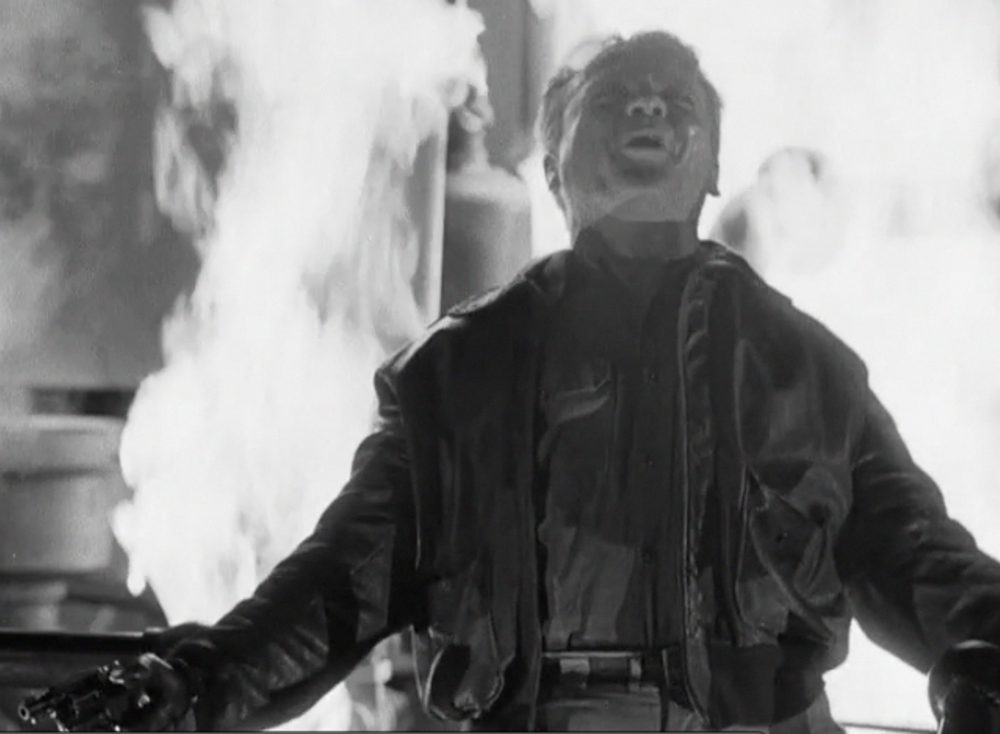
White Heat has left a resounding legacy in cinema. I think of Christopher Walken as a modern Cagney. Like Cagney, he started in vaudeville—or was it the circus? They’re both talented song and dance men but are perceived as being typecast in gangster roles despite having enjoyed varied careers. But I can see a strong connection between Walken in Abel Ferrara’s excellent gangster noir King of New York (1990) and Cagney in White Heat, and maybe it’s no accident that Walken’s character was named Frank White.
The gritty neo-noir thriller State of Grace (1990) revisited the themes with Gary Oldman as an unstable but sometimes likeable gangster and Sean Penn as an undercover cop infiltrating his ruthless gang. Deep Cover (1992) also drew inspiration from the same themes, only instead of the theft of federal funds the gangs were dealing in drugs. This time Laurence Fishburne is the DEA agent embroiled in an undercover operation to earn the friendship and trust of Jeff Goldblum’s suave, but also unbalanced, gangster.
John Woo drew so much from White Heat that parts of Face/Off (1997) can almost be read as a reboot—albeit with brotherly love in place of the mother-son relationship. The whole psycho in prison with an agent going undercover as a fellow convict certainly has strong parallels. Although only the second act of White Heat is set in a prison, it remains a definitive ‘prison film’ and established plenty of the tropes. John Woo instructed Nicolas Cage to study Cagney’s performance and use it to inform his portrayal of the crazy Castor Troy.
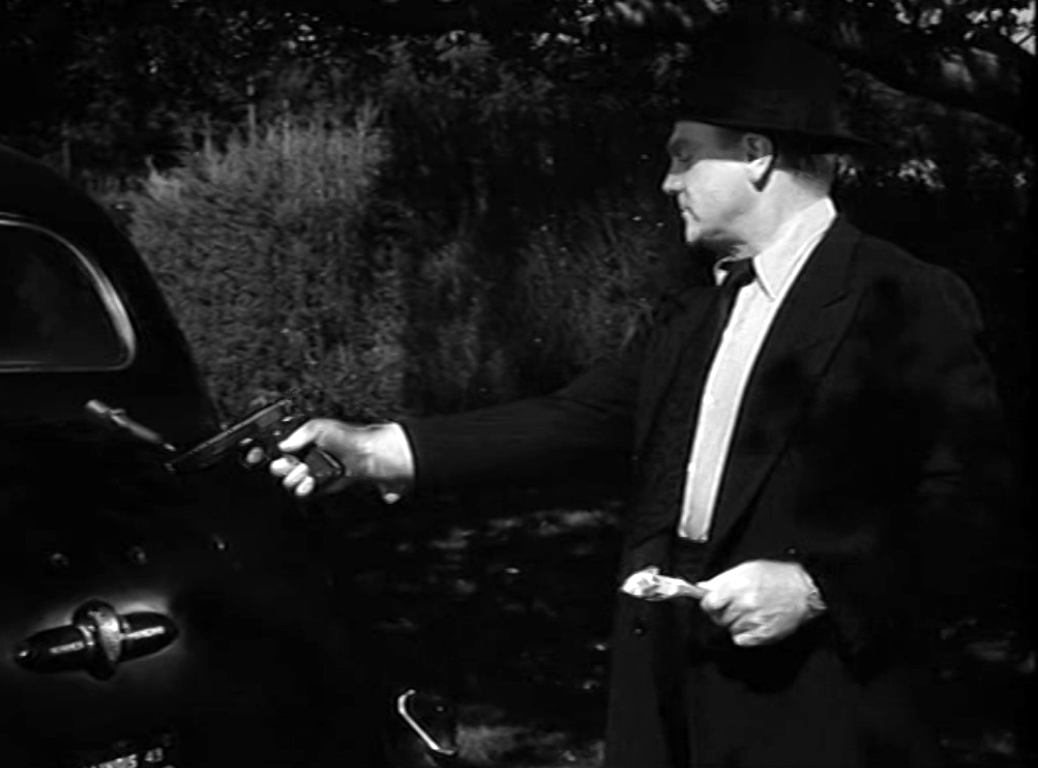
White Heat is often cited as the climax of Cagney’s career, but he remained popular and in-demand over the next decade. His next film was another strong noir-styled crime drama called Kiss Tomorrow Goodbye (1950). He worked with Raoul Walsh again for the political thriller A Lion is in the Streets (1953). He also played the gangster Martin Snyder, the svengali manager of singer Ruth Etting (Doris Day), in Love Me or Leave Me (1955), another unhinged criminal role that earned his third Oscar nomination.
Later, he made more musicals and comedies, and yes, comedy-musicals, but maybe the most interesting of his late-career period was playing the great Silent Era actor Lon Chaney in the biopic Man of a Thousand Faces (1957). By the 1960s, he was semi-retired, running a farm and dabbling in politics. There are rumours of a James Cagney biopic currently in development and, frankly, I’m surprised there hasn’t already been one.
But who could play the inimitable James Cagney?
Well, here’s some acting advice from the man himself: “Find your mark, look the other fellow in the eye, and tell the truth…”

director: Raoul Walsh.
writers: Ivan Goff & Ben Roberts (based on the novel by Virginia Kellogg).
starring: James Cagney, Virginia Mayo, Edmond O’Brien, Margaret Wycherly & Steve Cochran.
